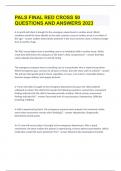Exam (elaborations)
PALS FINAL RED CROSS |50 QUESTIONS AND ANSWERS 2023.
- Course
- Institution
A 4-month old infant is brought to the emergency department in cardiac arrest. Which condition would the team identify as the most common cause of cardiac arrest in an infant of this age? sudden infant death syndrome is the most common cause in infants younger than 6 months of age. The PALS...
[Show more]



